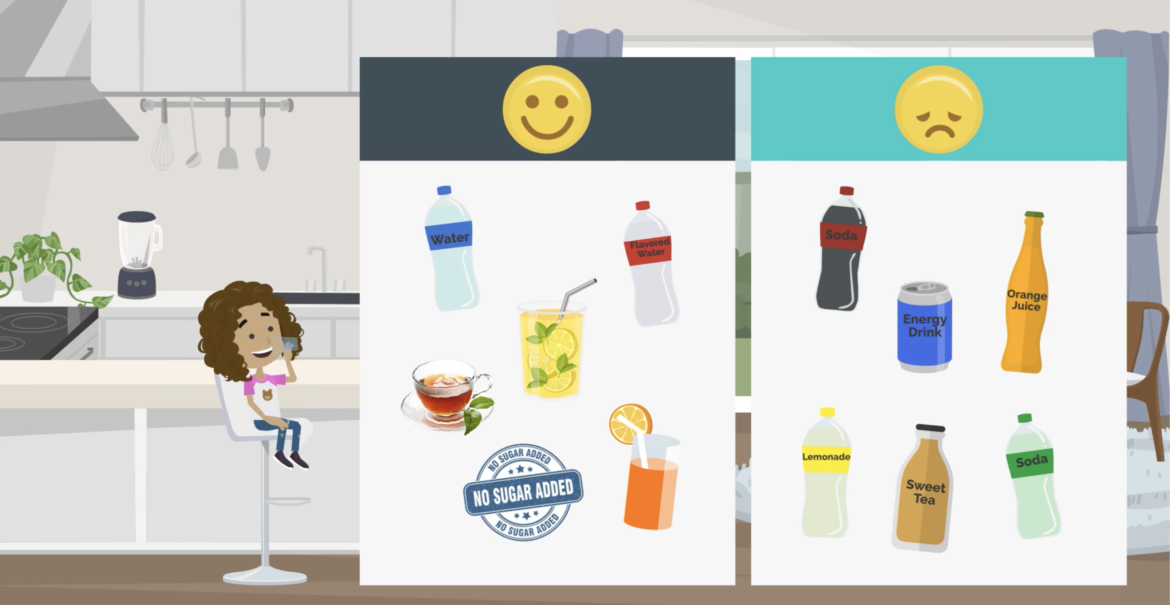Watch our video about liver health and diet for children!

30 Jan 2023 |
This video about the risk of fatty liver and combating it with diet for children was created by Lauren Roper, a UTHealth dietetic intern, to introduce a life-threatening condition that few people know about – fatty liver disease – and suggest how to prevent or slow its progression with one of many strategies – decreasing sugary drink consumption.
Fatty Liver-What is it and Why be Concerned?
Normally, a healthy liver assists in the digestion of proteins, fats, and carbohydrates, supports the muscles and immune system, regulates blood sugar levels, and removes toxins from the bloodstream. However, when the liver’s cells become filled with fat, it can cause inflammation and injury to the liver. Often people do not even know they have fatty liver disease. Poorly managed fatty liver disease can eventually scar the liver and increases the risk of liver failure.
Although there is still much to learn about the pathways through which people develop fatty deposits on their liver, the most common risk factors include genetics, high blood pressure, high cholesterol, obesity, and taking in too many calories, particularly from fat and sugar. It is an increasing problem and not just in adults, but in children too. Although you may not feel sick when you have fatty liver, it is still very important to manage the condition with diet and exercise if you want to prevent long-term complications. Luckily, fatty liver can be prevented or reversed with a balanced diet and healthy habits!
Simple Changes in What You Eat Can Make a Big Difference in Fatty Liver
While making changes in your diet and lifestyle can be intimidating, it doesn’t need to be complicated! Unfortunately, most of the recommendations regarding nutrition for fatty liver are focused on reducing overall weight but what really is key is improving health behaviors! In fact, diet quality and getting physical activity can improve fatty liver independent of weight loss.
Where to start? Making thoughtful drink choices is a great place to start. Sugary drinks are the main source of added sugars in the American diet and Americans eat too much sugar. The Dietary Guidelines for Americans recommend that if you eat sugar, the total should be less than 10% of your total daily calories. This is equivalent to no more than 200 calories from added sugars (about 12 teaspoons or 50g). That sounds like a lot but you get more sugar than that from a 16 ounce soft drink! (See the Texas Liver Foundation’s sugary drinks poster)
Look for “added-sugar” on food labels and choose items with less than 8 grams of added sugar per serving. Sparkling water is a great substitute for soda because it contains carbonation without added sugars. If you find plain water boring, you can infuse it with fresh fruits, lemon, cucumbers, mint, or other additions. Alternatively, some diet drinks are appropriate substitutes for sugary beverages. These drinks are usually labeled “diet” or “sugar-free.” It’s important to remember that your diet doesn’t need to be all or nothing; all foods can be enjoyed in moderation.
More ideas for liver health
Other strategies linked to better outcomes for people with fatty liver disease or for anyone who wants to improve their diet, include:
- Reduce saturated fat intake. Saturated fat is primarily found in animal products such as beef, pork, and some dairy products like butter and cheese.
- Increase unsaturated fats in your diet. Omega-3 fatty acids help reduce inflammation and fat deposits in the liver. Foods high in omega-3 fatty acids include fish (particularly salmon, trout, anchovies, and sardines), nuts, and seeds.
- Fill half of your plate with fruits and vegetables. Fruits and vegetables are high in vitamins, minerals, antioxidants, and fiber. Fiber plays a role in regulating blood sugars and binds to fat to help eliminate it from our bodies, reducing the total amount of fat we carry to the liver.
- Exercise. Regular physical activity in children results in lower body fat, stronger bones and muscles, and has brain health benefits for school-aged children, including improved academic performance and memory. It’s important that kids be physically active for one hour or more every day. This may include playing sports, dancing, walking or running, biking, swimming, and much more!
Reference U.S. Department of Agriculture and U.S. Department of Health and Human Services. Dietary Guidelines for Americans, 2020-2025. 9th Edition. December 2020. Available at DietaryGuidelines.gov.
